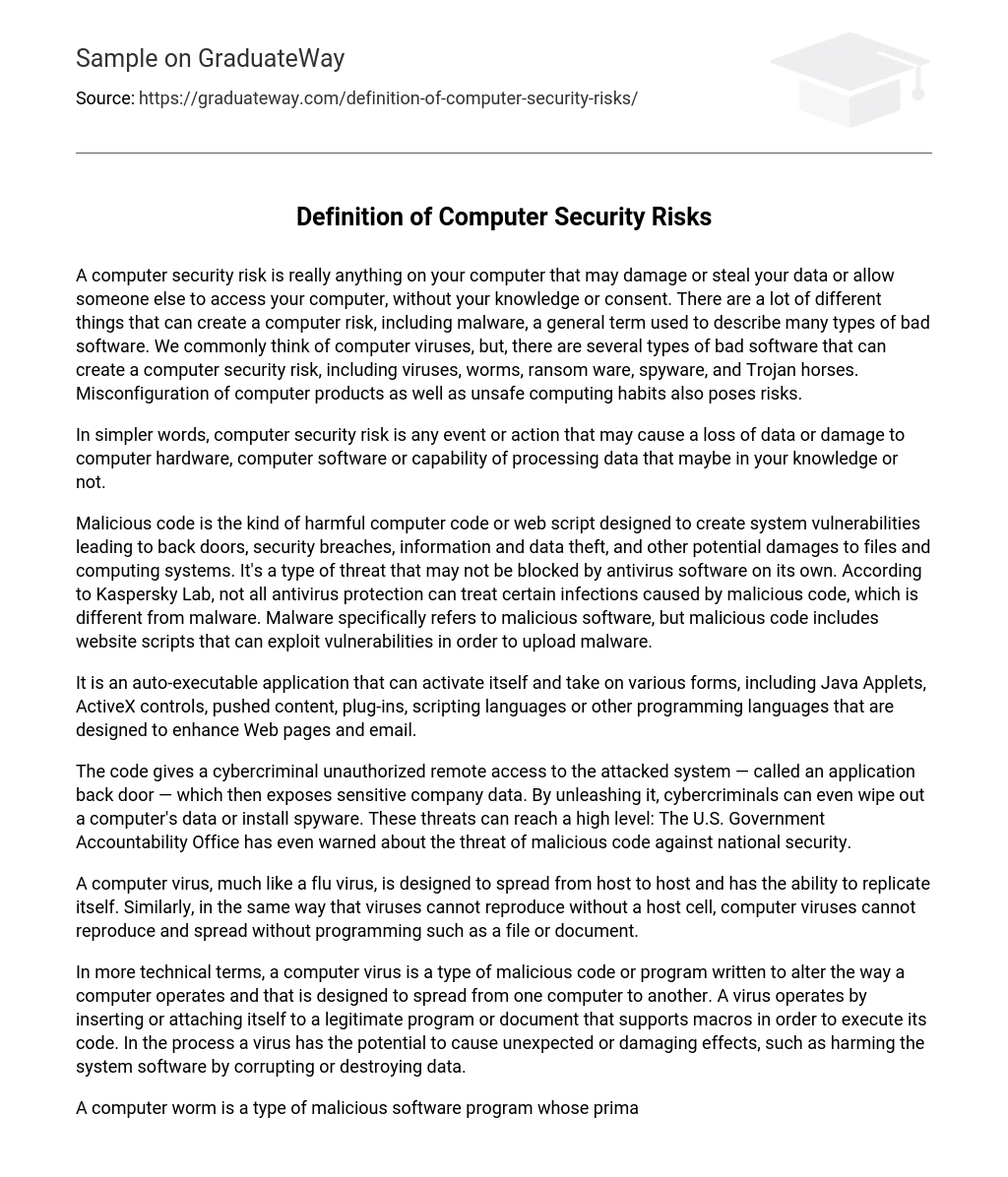A computer security risk is really anything on your computer that may damage or steal your data or allow someone else to access your computer, without your knowledge or consent. There are a lot of different things that can create a computer risk, including malware, a general term used to describe many types of bad software. We commonly think of computer viruses, but, there are several types of bad software that can create a computer security risk, including viruses, worms, ransom ware, spyware, and Trojan horses. Misconfiguration of computer products as well as unsafe computing habits also poses risks.
In simpler words, computer security risk is any event or action that may cause a loss of data or damage to computer hardware, computer software or capability of processing data that maybe in your knowledge or not.
Malicious code is the kind of harmful computer code or web script designed to create system vulnerabilities leading to back doors, security breaches, information and data theft, and other potential damages to files and computing systems. It’s a type of threat that may not be blocked by antivirus software on its own. According to Kaspersky Lab, not all antivirus protection can treat certain infections caused by malicious code, which is different from malware. Malware specifically refers to malicious software, but malicious code includes website scripts that can exploit vulnerabilities in order to upload malware.
It is an auto-executable application that can activate itself and take on various forms, including Java Applets, ActiveX controls, pushed content, plug-ins, scripting languages or other programming languages that are designed to enhance Web pages and email.
The code gives a cybercriminal unauthorized remote access to the attacked system — called an application back door — which then exposes sensitive company data. By unleashing it, cybercriminals can even wipe out a computer’s data or install spyware. These threats can reach a high level: The U.S. Government Accountability Office has even warned about the threat of malicious code against national security.
A computer virus, much like a flu virus, is designed to spread from host to host and has the ability to replicate itself. Similarly, in the same way that viruses cannot reproduce without a host cell, computer viruses cannot reproduce and spread without programming such as a file or document.
In more technical terms, a computer virus is a type of malicious code or program written to alter the way a computer operates and that is designed to spread from one computer to another. A virus operates by inserting or attaching itself to a legitimate program or document that supports macros in order to execute its code. In the process a virus has the potential to cause unexpected or damaging effects, such as harming the system software by corrupting or destroying data.
A computer worm is a type of malicious software program whose primary function is to infect other computers while remaining active on infected systems. A computer worm is self-replicating malware that duplicates itself to spread to uninfected computers. Worms often use parts of an operating system that are automatic and invisible to the user. It is common for worms to be noticed only when their uncontrolled replication consumes system resources, slowing or halting other tasks.A computer worm is not to be confused with WORM (write once, read many).
A destructive program that masquerades as a benign application. Unlike viruses, Trojan horses do not replicate themselves but they can be just as destructive. One of the most insidious types of Trojan horse is a program that claims to rid your computer of viruses but instead introduces viruses onto your computer.
The term comes from the a Greek story of the Trojan War, in which the Greeks give a giant wooden horse to their foes, the Trojans, ostensibly as a peace offering. But after the Trojans drag the horse inside their city walls, Greek soldiers sneak out of the horse’s hollow belly and open the city gates, allowing their compatriots to pour in and capture Troy.
Unauthorized access is when someone gains access to a website, program, server, service, or other system using someone else’s account or other methods. For example, if someone kept guessing a password or username for an account that was not theirs until they gained access, it is considered unauthorized access.
Unauthorized access could also occur if a user attempts to access an area of a system they should not be accessing. When attempting to access that area, they would be denied access and possibly see an unauthorized access message.
Some system administrators set up alerts to let them know when there is an unauthorized access attempt, so that they may investigate the reason. These alerts can help stop hackers from gaining access to a secure or confidential system. Many secure systems may also lock an account that has had too many failed login attempts.





